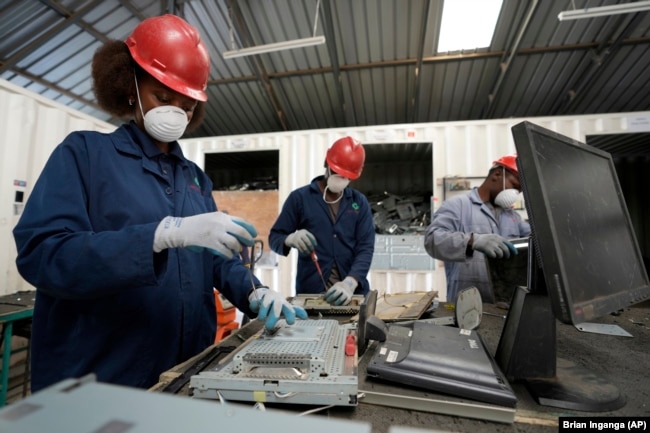AUDIO
UN Report: Electronic Waste Is Piling up

A United Nations report warns that no longer used electronics, called “e-waste,” is increasing worldwide. It adds that recycling rates of e-waste remain low.
The waste comes from devices such as mobile phones, electronic toys, TVs, microwave ovens, e-cigarettes, laptop computers, and solar panels.
The report does not include waste from electronic vehicles, which are counted separately.
The U.N.’s International Telecommunications Union (ITU) and the research group UNITAR wrote the report. It said about 62 million metric tons of “e-waste” were created in 2022. The report estimates the amount will increase 32 percent by 2030. The report said metals, including copper, gold, and iron, worth a total of about $91 billion are wasted.
The U.N. said 22 percent of e-waste was collected and recycled in 2022. The U.N. agencies expect that amount to fall to 20 percent by 2030 for several reasons. These include the increasing number of devices, lack of repairs, shorter device lifespan, and not enough waste management systems.

FILE - In this photo taken Monday, Aug. 18, 2014, a worker gathers handfuls of cellphone printed circuit boards from a pile to put in a sack for recycling, at the East African Compliant Recycling facility in Machakos, near Nairobi, in Kenya. (AP Photo/Ben Curtis, File)
Some of the e-waste contains dangerous substances, such as the element mercury, the report said. It also contains some rare-earth metals needed to make electronic devices. Currently, recycling supplies only one percent of the demand for the 17 rare metals.
The report said about half of all e-waste comes from Asia where few countries have laws on e-waste or collection targets. Recycling and collection rates are more than 40 percent in Europe. However, Europe also produces the highest amount of e-waste per person: nearly 18 kilograms.
Africa has the least e-waste of any of the five big regions worldwide. However, its recycling and collection rates are about 1 percent, the report said.
“The latest research shows that the global challenge posed by e-waste is only going to grow,” said Cosmas Luckyson Zavazava. He is head of the ITU telecommunication development group.
Collecting e-waste to survive
For some people, e-waste is a way to earn money by looking through trash to find valuable metals and parts. However, the work comes with health risks.
Dandora dumpsite is a place where waste from the city of Nairobi, Kenya is put. There, Steve Okoth tries to find material he can sell to businesses. But he knows the work can harm his health.

A woman who scavenges recyclable materials for a living, center, walks past Marabou storks feeding on a mountain of garage amidst smoke from burning trash at Dandora, the largest garbage dump in the capital Nairobi, Kenya Wednesday, March 20, 2024. (AP Photo/Brian Inganga)
“When the e-waste comes here, it contains some powder which affects my health,” he said. He added that when the e-waste heats up, it releases harmful gases and he “can’t come to work because of chest problems.”
Still, Okoth said he and others like him don’t have any other choice: “We are now used to the smoke because if you don’t go to work, you will not eat.”
Recycling centers and the environment
Kenya is taking steps to recycle e-waste. Nairobi’s WEEE recycling center has collection points across the country. People can safely give away old electronic equipment at these places.
Catherine Wasolia is WEEE’s chief operating officer. She said workers examine the devices for data and clean them. Then they test the devices to see if they can be reused in some way.

Employees dismantle laptop waste at WEEE center recycling plant, a collection point where people can deposit old electric equipment in Nairobi, Kenya Wednesday, March. 20, 2024. (AP Photo/Brian Inganga)
George Masila said that when it rains, water gets into the e-waste. He said this can harm water quality and could bring unwanted substances into the soil.
He said greater recycling and re-use of electronics, “are some of the things we should be considering.”
Writers of the UN report noted that many people in developing countries make money by recovering materials from e-waste. The report called for them to be trained and given safety equipment for their work.
_______________________________________________
Words in This Story
recycle –v. to reuse something or its parts and materials in an effort to save money, energy and to support the environment
lifespan –n. the length of time that a produce is expected to last
global –adj. relating to the whole world
pose –v. to present or to be something
powder –n. very fine particles of something
https://learningenglish.voanews.com/a/un-report-electronic-waste-is-piling-up/7537429.html